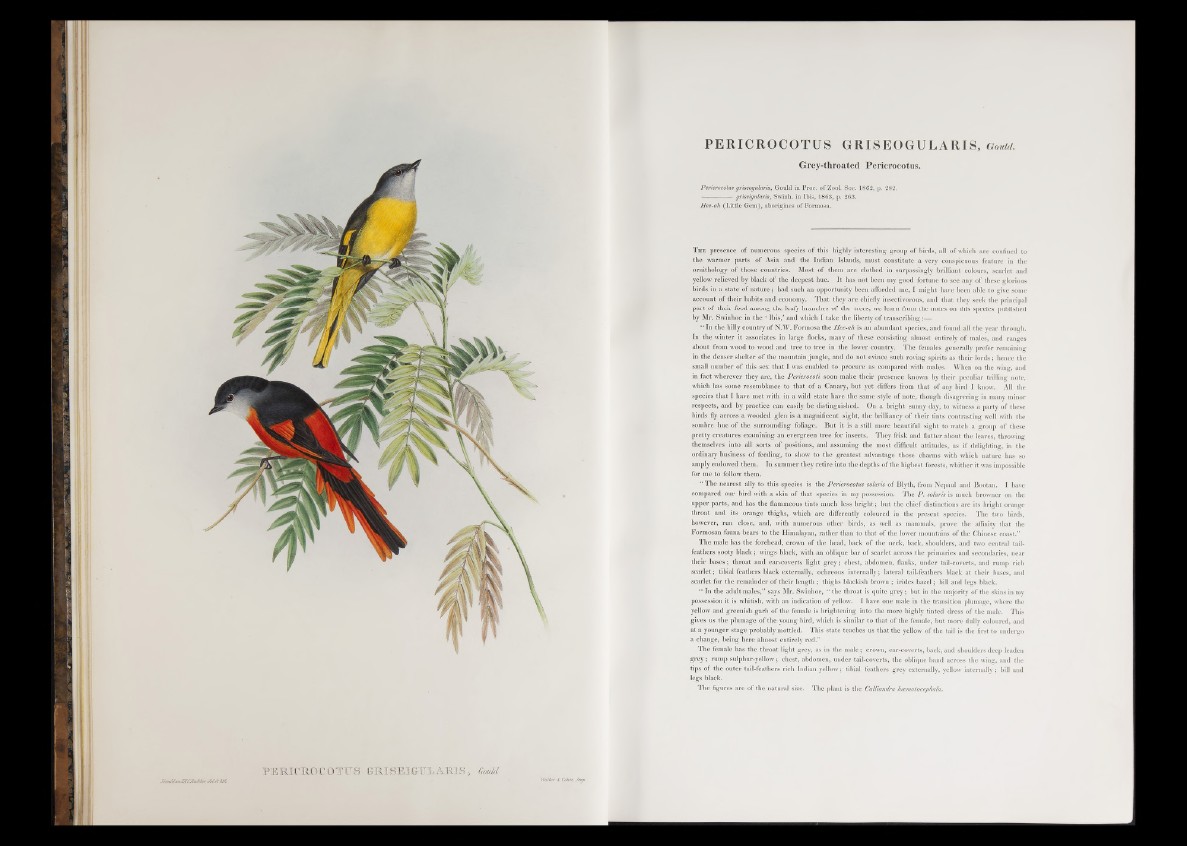
PERICTHOCOTTTS GRISE1G-TILAB.IS, Gould.
P E R I C R O C O T U S G R I S E O G U L A R I S , Gould.
Grey-throated Pericrocotus.
Pericrocotus griseogularis, Gould in Proc. of Zool. Soc. 1862, p. 282.
griseigularis, Swinh. in Ibis, 1863, p. 263.
Hee-ah (Little Gem), aborigines of Formosa.
T h e presence of numerous species of this highly interesting group of birds, all of which are confined to
the warmer parts of Asia and the Indian Islands, must constitute a very conspicuous feature in the
ornithology of those countries. Most of them are clothed in surpassingly brilliant colours, scarlet and
yellow relieved by black of the deepest hue. It has not been my good fortune to see any of these glorious
birds in a state of na tu re ; had such an opportunity been afforded me, I might have been able to give some
account of their habits and economy. That they are chiefly insectivorous, and that they seek the principal
part of their food among the leafy branches of the trees, we learn from the notes on this species published
by Mr. Swinhoe in the ‘ Ibis,’ and which I take the liberty of transcribing:—
“ In the hilly country of N.W. Formosa the Hee-ah is an abundant species, and found all the year through.
In the winter it associates in large flocks, many of these consisting almost entirely of males, and ranges
about from wood to wood and tree to tree in the lower country. The females generally prefer remaining
in the denser shelter of the mountain jungle, and do not evince such roving spirits as their lords; hence the
small number of this sex that I was enabled to procure as compared with males. When on the wing, and
in fact wherever they are, the Pericrocoti soon make their presence known by their peculiar trilling note,
which has some resemblance to that of a Canary, but yet differs from that of any bird I know. All the
species that I have met with in a wild state have the same style of note, though disagreeing in many minor
respects, and by practice can easily be distinguished. On a bright sunny day, to witness a party of these
birds fly across a wooded glen is a magnificent sight, the brilliancy of their tints contrasting well with the
sombre hue of the surrounding foliage. But it is a still more beautiful sight to watch a group of these
pretty creatures examining an evergreen tree for insects. They frisk and flutter about the leaves, throwing
themselves into all sorts of positions, and assuming the most difficult attitudes, as if delighting, in the
ordinary business of feeding, to show to the greatest advantage those charms with which nature has so
amply endowed them. In summer they retire into the depths of the highest forests, whither it was impossible
for me to follow them.
“ The nearest ally to this species is the Pericrocotus Solaris of Blyth, from Nepaul and Bootan. I have
compared our bird with a skin of that species in my possession. The P. Solaris is much browner on the
upper parts, and has the flammeous tints much less b right; but the chief distinctions are its bright orange
throat and its orange thighs, which are differently coloured in the present species. The two birds,
however, run close, and, with numerous other birds, as well as mammals, prove the affinity that the
Formosan fauna bears to the Himalayan, rather than to that of the lower mountains of the Chinese coast.”
The male has the forehead, crown of the head, back of the neck, back, shoulders, and two central tail-
feathers sooty black ; wings black, with an oblique bar of scarlet across the primaries and secondaries, near
their bases; throat and ear-coverts light g rey ; chest, abdomen, flanks, under tail-coverts, and rump rich
scarlet; tibial feathers black externally, ochreous internally; lateral tail-feathers black at their bases, and
scarlet for the remainder of their length; thighs blackish brown ; irides hazel; bill and legs black.
“ In the adult males,” says Mr. Swinhoe, “ the throat is quite g rey ; but in the majority of the skins in my
possession it is whitish, with an indication of yellow. I have one male in the transition plumage, where the
yellow and greenish garb of the female is brightening into the more highly tinted dress of the male. This
gives us the plumage of the young bird, which is similar to that of the female, but more dully coloured, and
at a younger stage probably mottled. This state teaches us that the yellow of the tail is the first to undergo
a change, being here almost entirely red.”
The female has the throat light grey, as in the male; crown, ear-coverts, back, and shoulders deep leaden
g rey ; rump sulphur-yellow; chest, abdomen, under tail-coverts, the oblique band across the wing, and the
tips of the outer tail-feathers rich Indian yellow; tibial feathers grey externally, yellow internally; bill and
legs black.
The figures are of the natural size. The plant is the Calliandra hcematocephala.